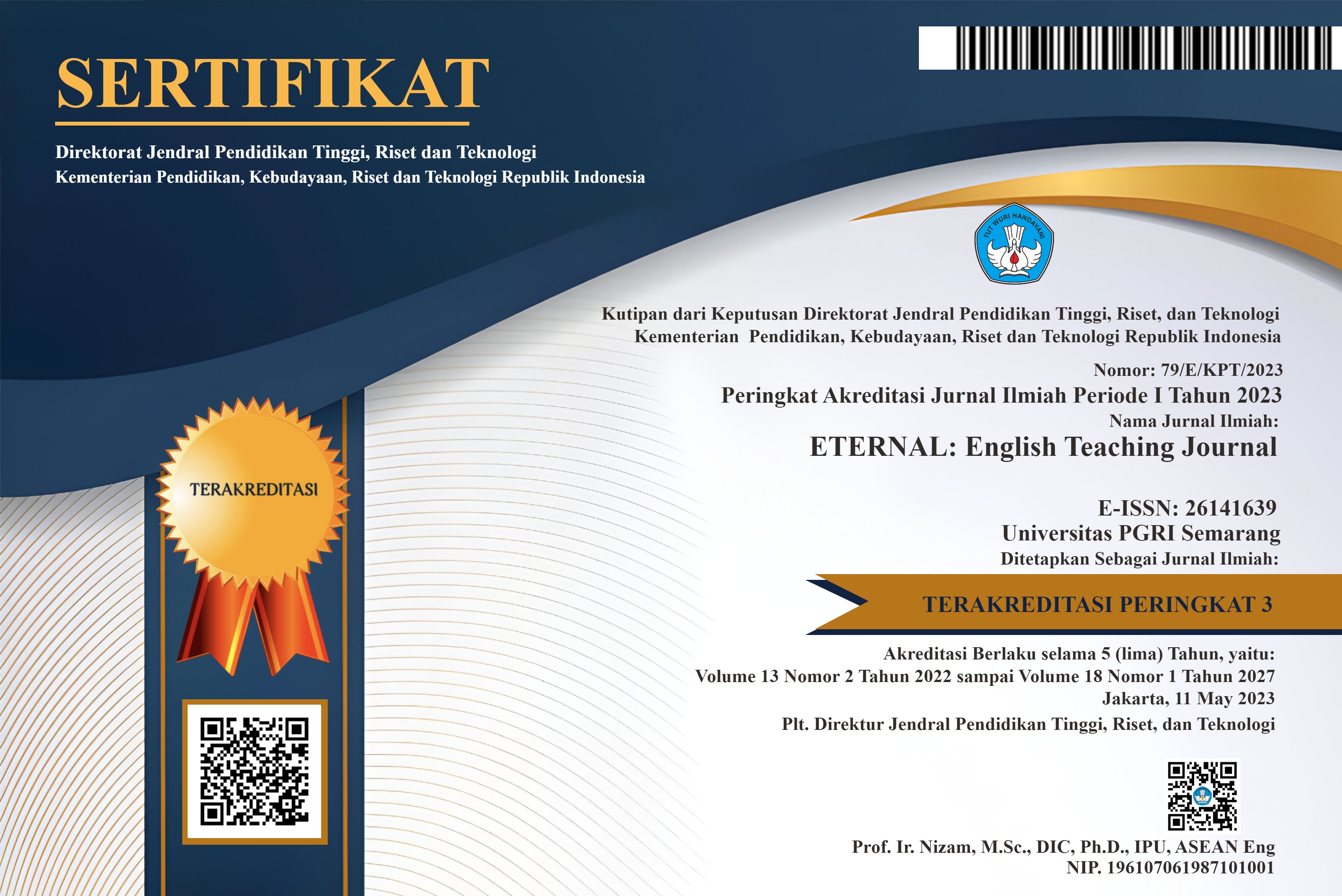Structural Contrast in William Blake’s “The Tyger” and “The Lamb”
DOI:
https://doi.org/10.26877/eternal.v15i2.749Keywords:
Structuralism, Binary Opposition, Structural Elements, ThemeAbstract
Structuralism is a theory focusing on analyzing the structure of a text and the relationship between the elements in order to get the meaning of literary works. Binary opposition is an important concept of structuralism, it is a concept or idea that can gain meaning through its relationship with its opposite. William Blake’s “The Tyger” and the “The Lamb” are two poems contain a lot of meaning that opposites each other. This study address several aspects related to the binary opposition of structuralism in the poems “The Tyger” and “The Lamb” by William Blake: (1) The structural elements in the poems “The Tyger” and “The Lamb” by William Blake. (2) The way “The Tyger” and “The Lamb” by William Blake employ binary oppositions in their structure to convey contrasting themes. (3) The influence of binary opposition on the overall meaning and interpretation of “The Tyger” and “The Lamb” by William Blake. (4) The benefits of using structuralism in poetry for language teaching, and how these can be addressed in teacher training programs. This study applied a qualitative method and context-oriented approach. This study shows that by utilizing structural elements, thematic explorations, tone, language style, and binary oppositions, Blake develops two mutually enhancing yet opposing perspectives on creation and divine existence. The strong and frightening Tyger is in stark contrast with the meek and pure Lamb, representing the intricate nature of life and the various facets of spirituality. This resistance goes beyond just the use of animal imagery, affecting the themes, tone, and language in every poem. Blake prompts readers to confront the contradictions of existence by juxtaposing light with darkness, innocence with experience, and nature with divinity. Studying poetry can be difficult because of different levels of literary skill, teaching methods, and tools, but it provides many academic benefits. Poetry nurtures a greater love for literature, improves creative skills and critical thinking, and aids.
References
Anggraini, N., Sumardiyani, L., Hawa, F. (2017). ‘Metaphorical Symbols Used in Linkin Park’s Song Lyrics and Its Contribution to Teaching Poetry’. English Teaching Journal 8(2). doi: https://doi.org/10.26877/eternal.v8i2.2829.
Anindita, K.A., Satoto, S., Sumarlam. (2017). ‘Diction in Poetry Anthology Surat Kopi by Joko Pinurbo as A Poetry Writing Teaching Material’. International Journal of Active Learning 2(1):39–49.
Arianto, T. (2018). ‘National Romanticism in Walt Whitman Poems’. LIRE Journal: Journal of Linguistics and Literature 2(1):17–23. doi: http://dx.doi.org/10.33019/lire.v2i1.18.
Barbosa de Almeida, M. W. (2015). ‘Structuralism’. Pp. 626–31 in International Encyclopedia of the Social & Behavioral Sciences. Oxford: Elsevier.
Chakraborty, S. (2020). ‘William Blake: “The Lamb” & “The Tyger”’. Raja Narendralal Khan Women’s College.
Chanmann, C., M. Taylor, S. Bleyle, Y. Hwang, and K. Zhang. (2016). ‘“Teaching Poetry in TESOL Teacher Education: Heightened Attention to Language as Well as to Cultural and Political Critique Through Poetry Writing”,’.
Chris, M.J. (2021). Poetry: The Structural Elements. San José.
Chunmei, Y. (2018). ‘Analysis on the Binary Oppositions of Django Unchained’. International Journal of Humanities Social Sciences and Education (IJHSSE) 5(2):108–12. doi: https://doi.org/10.20431/2349-0381.0502012.
Devi, K.I., Nanikumar, S. (2018). ‘Discussion on T S Eliot’s Poetic Theory: A Review’. International Journal of Linguiatics and Literature (IJLL) 7(3):19–26.
Douglas, C. (2012). ‘Image and Poetry in Selected Early Works of William Blake: Producing a Third Text Volume 1 of 2’. University of the Witwatersrand.
Eliasari, E. (2018). ‘Students’ Difficulties in Learning Poetry at Faculty of Cultural Science of Mulawarman University Academic Years 2017/2018’. Journal of English Teaching, Linguistic, and Literature 1 (1), 2018, 10-23.
Gillespie, C., I. Dong, Wamae, H. (2018). ‘William Blake’s “The Tyger” and “The Lamb”’. British Literature.
Iida, A. (2016). ‘“Poetic Identity in Second Language Writing: Exploring an EFL Learner’s Study Abroad Experience”,’. Eurasian Journal of Applied Linguistics, 2(1), Pp. 1-14.).
Illankumaran, M., Deepa, P. (2018). ‘Teaching Literature Enhances Communication Skills – a Study with Special Emphasis on Poetry’. International Journal of Engineering & Technology. 7(3.6) Pages 187-191.
Gönen, K., Safiye, I. (2018). ‘Implementing Poetry in the Language Class: A Poetry-Teaching Framework for Prospective English Language Teachers’. Advances in Language and Literary Studies 9(5):28.
Mansoor, S., Khan, A.B. (2016). ‘Critical Analysis of William Wordsworth’s Poetic Diction’. Journal of Literature, Language and Linguistics 20.
Memon, M.I., Rao, S. Siyal, S. (2021). ‘Structuraist Study of Saussurean Binary Oppositions in Ahmed Ali’s Novel “Twilight in Delhi”’. International Journal of English Research 7(2):23–25.
Munawar, B. (2016). ‘Structuralistic Analysis of the Poem “The Stone Chat” by Taufeeq Rafat in Perspective of Binary Opposition’. International Journal of Applied Linguistics and English Literature 5(4). doi: http://dx.doi.org/10.7575/aiac.ijalel.v.5n.4p.122.
Nugrahawati, A.W. (2014). ‘Representation of Ideological Conflict in the J. R. R. Tolkien’s Trilogy The Lord of the Rings Novel (1937-1949)’. Muhammadiyah University of Surakarta.
Paul, J.C. (2015). ‘Skinning “The Lamb” and “The Tyger”’. English Language and Literature Studies 5(2). doi: 10.5539/ells.v5n2p87.
Putri, A., Sarwoto, P. (2016). ‘Saussurian Binary Opposition as the Narrative Structure of Williams’ Summer and Smoke’. Journal of Language and Literature 16(1). doi: https://doi.org/10.24071/joll.v16i1.154.
Risdianto, F. (2014). ‘A Handbook of English Literature by Faizal Risdianto’.
Samanik, S. (2018). ‘Teaching English Using Poetry: An Alternative to Implement Contextual Teaching and Learning’. Journal of ELT Research 3(1):21.
Segre, S. (2020). ‘Structuralism’. Pp. 250–71 in The Handbook of Social Theory, edited by P. Kivisto. Cambridge University Press.
Susanti, H. (2021). ‘An Analysis of Figurative Language on Pablo Neruda Poems’. State Islamic University of Raden Intan Lampung.
Živković, D. (2020). ‘Mythological Transformations in the Poem “The Tyger” by William Blake and the Cycle “There Was a Tiger Here” by Gregor Strniša’. Primerjalna Književnos 43(2). doi: 10.3986/pkn.v43.i2.11.
Zou, X. (2023). ‘Myth Theory and Structuralism—A Study of Lévi- Strauss’s Mythological Research from Myth and Meaning’. Social Science, Humanities, and Sustainability Research 4(3). doi: http://dx.doi.org/10.22158/sshsr.v4n3p106.







